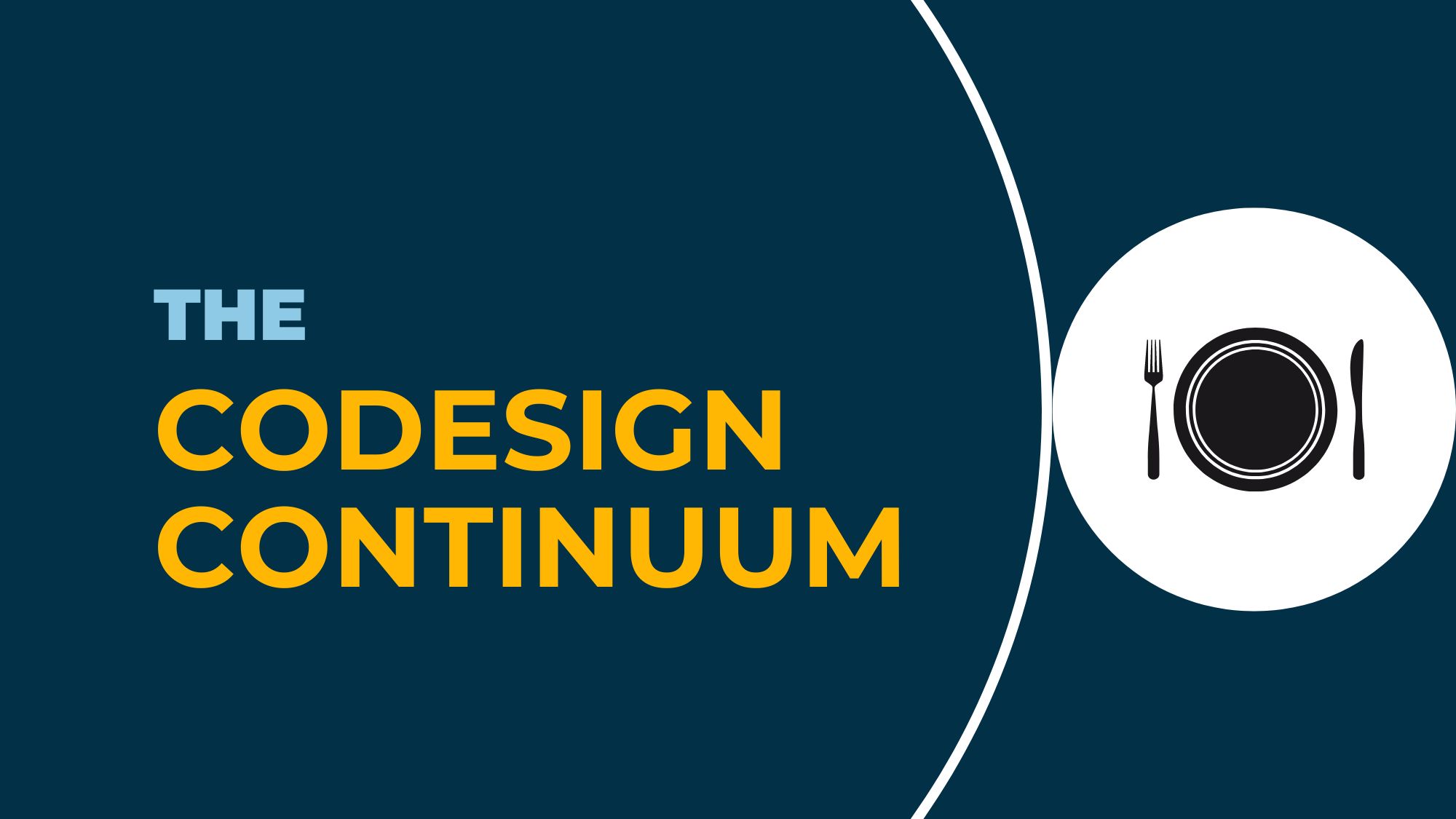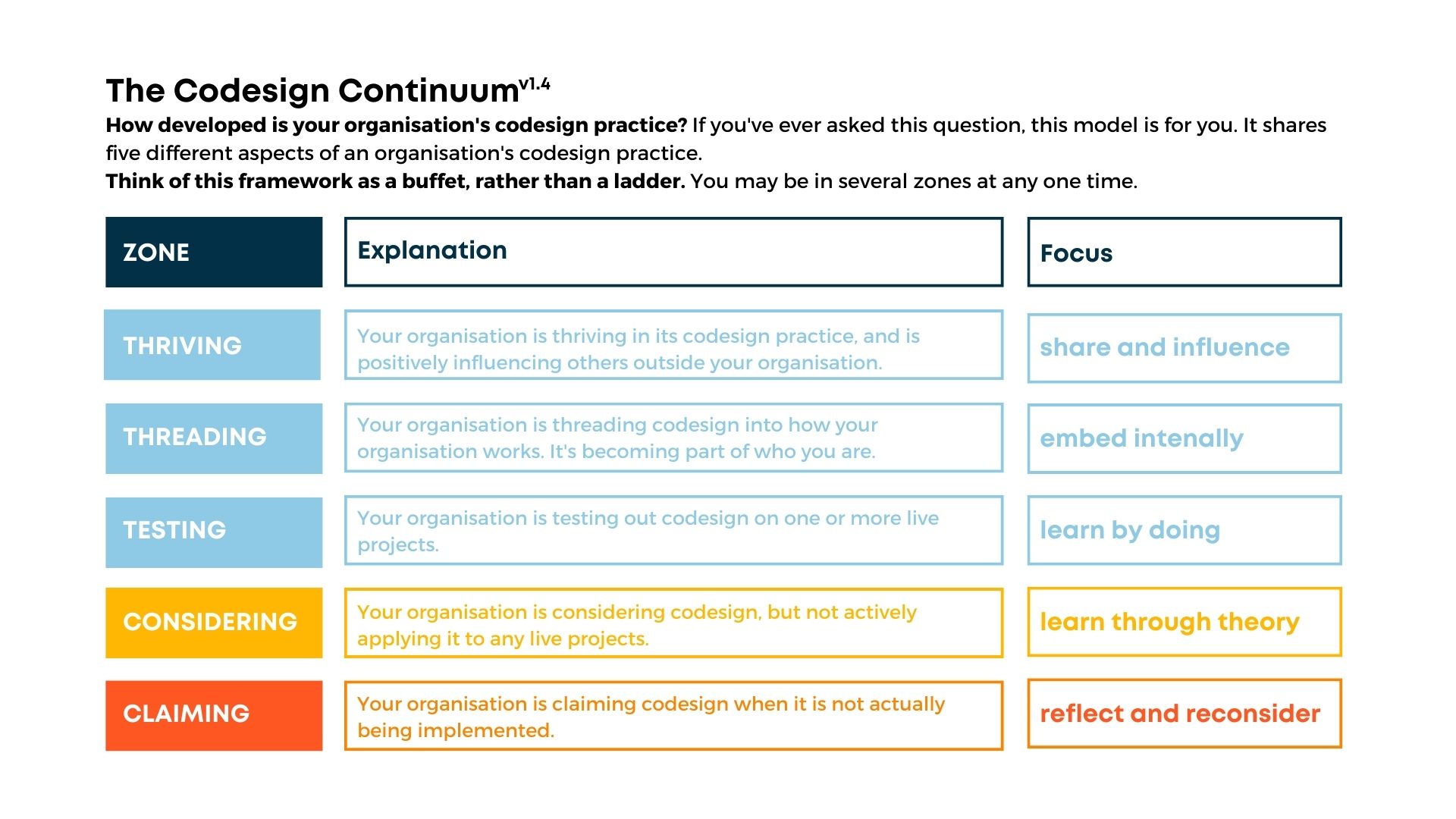The Codesign Continuum - What if the main barrier to good codesign is your organisation?

Codesign is a buzzword, people sometimes assure me.
Really?
Involving people with real experience of the issues you're working on is a passing fad...?
Um, okay.
I think what they're really meaning is that codesign is not the magical fix-all solution they hoped it would be.
Recently I attended the Talk It Up Unconference with 100 local government engagement practitioners.
I was invited to facilitate a workshop on codesign, and surveyed the participants on what they have found challenging about codesign.
Most of them spoke about creating the conditions for codesign within their own organisation.
I wasn't surprised.
Yes, codesign can be exciting, fun, transformative, and enlivening. But it can also be draining, tiring, tough and intense.
That's because codesign invites us to address the elephants in the room. Things like your own privileges. Or your organisation's tendency to hold power close to its chest.
INTRODUCING THE CODESIGN CONTINUUM

In preparation for the workshop, I dug out an old idea.
I had always thought it would helpful to have a developmental model to show how organisations can grow and develop their codesign practice.
I liken the model to a buffet, rather than a ladder.
With a ladder, you can only be on one or two rungs at a time.
With a buffet, however, you can help yourself to everything all at once. And just like a buffet, there's one zone on this model that is like a nasty prawn cocktail!
Claiming
Let's start with the claiming zone.
This is when you claim codesign... but there is no true codesign.
This zone creates distrust.
This is the prawn cocktail that gives you a right old stomach ache. It might look and sound good, but you only live to regret it.
I've been involved in projects where this has happened. It hurts, especially when you put yourself wholeheartedly into the work - only to be blindsided by changing priorities or interests further up the food chain.
Here are three big reasons why this seems to happen. I'm sure there are more, but these are the ones I've observed or experienced.
- The project team wanted to codesign, but senior leadership later took on the decision-making.
- The project team didn't quite understand what was meant by codesign. They called it codesign because of the interactive methods they used, but there was no real power-sharing.
- The project team underestimated the effort required for codesign and ran out of budget, resources, time, energy or organisational mandate part-way through.
Personally, I think it's helpful to label this claiming zone so we can be mindful of ensuring our codesign work doesn't fall into this space. But if you would prefer a purely strengths-based approach, you may prefer Emma Blomkamp's codesign maturity model.
Considering
Some organisations stay in the considering zone for years. I've been talking with one organisation for the last two years and they remain in this space, despite lots of good work by talented people to shift them out of it. Codesign remains an aspiration, a theory.
This zone is all about learning the theory of codesign. You might be discussing it internally, reading books, watching videos, consuming articles... and continuing to build the case for codesign.
It's an important zone. And it's one you might return to many times after you have started applying codesign in real live projects.
This zone is all about questions.
It's a self-reflective space where you are considering things like:
- What is codesign?
- Should we be codesigning?
- How can we codesign in our context?
- How will we know if this codesign has been successful?
- Are we the right people to do this codesign work?
- What can we build on?
- How will my experiences and background impact this codesign project?
- (And so many more questions...!)
Testing
At some stage, you start testing out codesign for real.
This zone creates lots of insights.
Finally, you're putting all that theory to use. Your focus now is on learning by doing, not just learning by theory.
You're learning about yourself, your organisation, your relationships, your project, the people you're working with, and more.
This may lead to more questions (considering). Or it may lead you towards the next zone.
Threading
If weaving started with the letter 'T' then I would have called this zone the weaving zone.
This zone is all about embedding codesign internally.
In my experience, often the biggest barrier to good codesign is your own organisation's culture and beliefs. This is backed up by a 2020 literature review of codesign in Aotearoa New Zealand.
Many of the beliefs behind codesign run counter to the "normal" way of doing things in today's organisations.
And that's because many of our organisational norms prioritise certain behaviours over others:
- Logic is prioritised over emotion
- Speed is prioritised over care
- Being right is more important than being honest
- Delivery is prioritised over relationships
- And so on.
I'm generalising, of course, but you get the point.
This is why Kelly-Ann McKercher talks about codesign being a movement. It's about shifting what makes it so hard to implement codesign at times.
So when we're looking at how to thread codesign into your organisation, this is often about addressing the underlying beliefs, power dynamics, relationships and resourcing structures that enable (and disable) good codesign.
Thriving
This zone is where you're really pushing the boundaries of your codesign practice. You're innovating, creating new tools/resources/models/approaches - and you're sharing that with the world. In so doing, you influence the broader systems around you that might in turn make it easier for the next codesign project or codesigning organisation.
The Auckland Codesign Lab stands out as a top example of a thriving codesign organisation. They regularly share developments in their practice and invest into developing new models and approaches - with a particular emphasis on connecting the dots between codesign and kaupapa-Māori design.
The key difference between this zone and the threading zone? This zone is about influencing outside your organisation, whereas the Threading zone is about influencing within your organisation.
Remember - it's a buffet, not a ladder
You can inhabit one, some or all of these zone at once.
You don't just reach the thriving zone and call it a day. In one week, you may be considering, testing, threading and thriving... and then you may fall into the claiming zone when a senior leader or commissioner pulls the rug out from under you.
Acknowledgements
My development of this model was inspired by many conversations, articles and experiences.
The initial idea sat as a rough note on my computer for three years before I was invited to deliver a workshop at Talk It Up in 2023 on the conditions for codesign. Before the workshop, I asked people to share the main barriers to codesign they had faced. The biggest barrier was their own organisation.
It reminded me of that rough old note, and I got to work!
In the course of refining the model, I would like to acknowledge the influence of:
- Penny Hagen's Mapping and Mobilising Youth Wellbeing model (developed when we were colleagues at LifehackHQ)
- Co-design in Aotearoa New Zealand: a snapshot of the literature (particularly the challenges section)
- Emma Blomkamp's Codesign Maturity model, which inspired me to differentiate between influencing outside your organisation (what I've called Thriving ) and influencing within your organisation (what I've called Threading)
- The Development Continuum I learned about in IAP2's Building an Engaging Organisations course, which suggests four stages of development in building an engaging organisation: Initiate, Infect, Improve and Inspire.